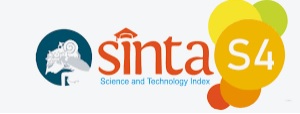Analisis Sentimen Terhadap Aplikasi Lowongan Kerja Menggunakan Lexicon Based Features Dan Support Vector Machine
Abstract
The use of job vacancy platforms is often used by job seekers. After users utilize the platform or job vacancy application, quite a few users leave reviews on the application so it is necessary to conduct a study regarding sentiment analysis of job vacancy applications using Lexicon based features and Support vector machines (SVM). The aim of this research is to find out the results of applying the Lexicon based method features and support vector machine for sentiment analysis of job vacancy applications. The research method used is Lexicon based features and Support vector machine with 3 research objects, namely Glints, Pintarnya and Kupu. Data collection was carried out through a scraping process on job vacancy applications in the Google Play Store. The collected data will be processed, carried out by TF-IDF, studied using Lexicon based features and support vector machines and then evaluated so that research results can be obtained that can be accounted for. The research results show that the approach through a combination of TF-IDF, Lexicon based features, and SVM with hyperparameter tuning produces good performance in sentiment analysis on text data with accuracies of 81% (Glints), 76% (Butterfly), and 82% for the Smart application
Keywords: Sentiment Analysis; Job Vacancies Application; Lexicon Based Features; Support Vector Machine
Â
Abstrak
Setelah pengguna memanfaatkan platform atau palikasi lowongan kerja dalam mencari kerja, tidak sedikit para pengguna meninggalkan ulasan pada aplikasi tersebut sehingga perlu dilakukan kajian mengenai analisis sentimen terhadap aplikasi lowongan kerja tersebut. Tujuan penelitian ini adalah untuk mengetahui hasil dari penerapan metode Lexicon based features dan Support Vector Machine (SVM) terhadap analisis sentimen aplikasi lowongan kerja. Metode penelitian yang digunakan ialah Lexicon based features dan Support vector machine dengan 3 objek penelitian yaitu Glints, Pintarnya dan Kupu. Pengumpulan data dilakukan melalui proses scraping pada aplikasi lowongan kerja yang ada di Google play store. Data yang terkumpul akan di proses, dilakukan TF-IDF, dikaji melalui Lexicon based features dan Support vector machine kemudian dievaluasi sehingga diperoleh hasil penelitian yang dapt dipertanggung jawabkan. Hasil penelitian menunjukkan bahwa pendekatan melalui kombinasi TF-IDF, fitur berbasis leksikon, dan SVM dengan penyetelan hyperparameter menghasilkan performa yang baik dalam analisis sentimen pada data teks dengan akurasi 81% (Glints), 76% (Kupu), dan 82% untuk aplikasi Pintarnya.
Keywords
References
S. Ari Agustina, Khairul Saleh, “Hubungan Kesejahteraan Karyawan Dengan Kinerja Karyawan Pada Hotel Lusy,†vol. 02, no. 02, pp. 22–28, 2018.
D. Dwi Wahyuni Ambali, L. Banne Allo, and J. Mambaya, “Hubungan Tingkat Pendapatan Dan Pekerjaan Orang Tua Dengan Gaya Hidup Mahasiswa S1 Keperawatan Semester Iv Stikes Tana Toraja Kabupaten Toraja Utara Tahun 2018,†J. Ilm. Kesehat. Promot., vol. 5, no. 2, pp. 165–185, 2021, doi: 10.56437/jikp.v5i2.61.
S. G. Nyoman, “Pengaruh Tingkat Pendidikan dan Jenis Pekerjaan Terhadap Produktivitas dan Pendapatan Keluarga Miskin Kecamatan Negara Jembrana,†E-Jurnal EP Unud, vol. 9, pp. 2529–2556, 2020.
B. K. Widodo, N. H. Matondang, and D. S. Prasvita, “Penerapan Algoritma Naive Bayes Untuk Analisis Sentimen Penggunaan Aplikasi Jobstreet,†Techno.Com, vol. 21, no. 3, pp. 523–533, 2022, doi: 10.33633/tc.v21i3.6361.
I. Ritonga, S. S., Setiawan, E. B., & Kurniawan, “Analisis Trending Topik Pada Twitter menggunakan Metode Naive Bayes dengan,†e-proceeding Eng., vol. 7, no. 1, pp. 2806–2816, 2020.
A. Syakur, “Implementasi Metode Lexicon Base Untuk Analisis Sentimen Kebijakan Pemerintah Dalam Pencegahan Penyebaran Virus Corona Covid-19 Pada Twitter,†J. Ilm. Inform. Komput., vol. 26, no. 3, pp. 247–260, 2021, doi: 10.35760/ik.2021.v26i3.4720.
A. A. Nurfalah, A., Adiwijawa. & Suryani, “Analisis Sentimen Berbahasa Indonesia dengan Pendekatan Lexicon-Based pada Media Sosial Twitter,†J. Masy. Inform. Indones., vol. 2, no. 1, pp. 1–8, 2017.
P. M. N. D. and N. L. P. Merawati, “Penerapan Algoritma Support Vector Machine Dalam Sentimen Analisis Terkait Kenaikan Tarif BPJS Kesehatan,†J. Bumigora Inf. Technol., vol. 2, no. 2, pp. 105–112, 2020, doi: 10.30812/bite.v2i2.904.
R. Andika, L. A., Azizah, P. A. N., & Respatiwulan, “Analisis Sentimen Masyarakat terhadap Hasil Quick Count Pemilihan Presiden Indonesia 2019 pada Media Sosial Twitter Menggunakan Metode Naive Bayes Classifier.,†Indones. J. Appl. Stat., vol. 2, no. 1, pp. 34-41, 2019, doi: https://doi.org/10.13057/ijas.v2i1.29998.
L. Himawan, H., Kaswidjanti, W., Sentimen, A., Sosial, M., & Based, “Metode Lexicon Based dan Support Vector Machine untuk Menganalisis Sentimen pada Media Sosial sebagai Rekomendasi Oleh-Oleh Favorit,†in Seminar Nasional Informatika, 2018, pp. 235–244.
& I. Ruslim, K. I., Adikara, P. P., “nalisis Sentimen Pada Ulasan Aplikasi Mobile Banking Menggunakan Metode Support Vector Machine dan Lexicon Based Features,†J. Pengemb. Teknol. Inf. Dan Ilmu Komput., vol. 3, no. 7, pp. 6694–6702, 2019.
M. A. Abdullah and D. Mahdiana, “Analisis Sentimen terhadap Peluang Kerja di Indonesia selama Masa Pandemi COVID-19 dengan Metode Klasifikasi Naive Bayes,†J. Media Inform. Budidarma, vol. 6, no. 2, pp. 1234, 2022, doi: 10.30865/mib.v6i2.3972.
I. B. T. Nova Andre Saputra, Jessica Alexandra, “Analisis Sentimen Pemanfaatan Obrolan Grup Telegram Berbagi Informasi Lowongan Kerja Menggunakan Metode Naïve Bayes Classifier,†J. Mhs. Tek. Inform., Vol. 7, No. 2, pp. 1321–1327, 2023.
M. Handayani, Y., Hakim, A. R., “Sentiment analysis of Bank BNI user comments using the support vector machine method. Proceedings - 2020 International Seminar on Application for Technology of Information and Communication: IT Challenges for Sustainability, Scalability, and Security in t,†in ISemantic, 2020, pp. 202–207. doi: https://doi.org/10.1109/ iSemantic50169.2020.9234230.)
M. B. Mahendrajaya, R., Buntoro, G. A., & Setyawan, “Analisis Sentimen Pengguna Gopay Menggunakan Metode Lexicon Based Dan Support Vector Machine.,†Komputek, vol. 3, no. 2, pp. 52-57, 2019, doi: https://doi.org/10.24269/jkt.v3i2.270.
How To Cite This :
Refbacks
- There are currently no refbacks.











